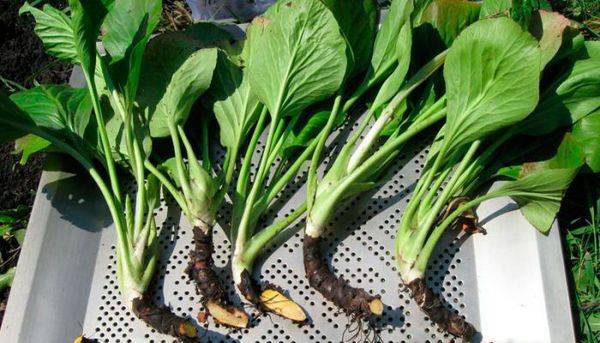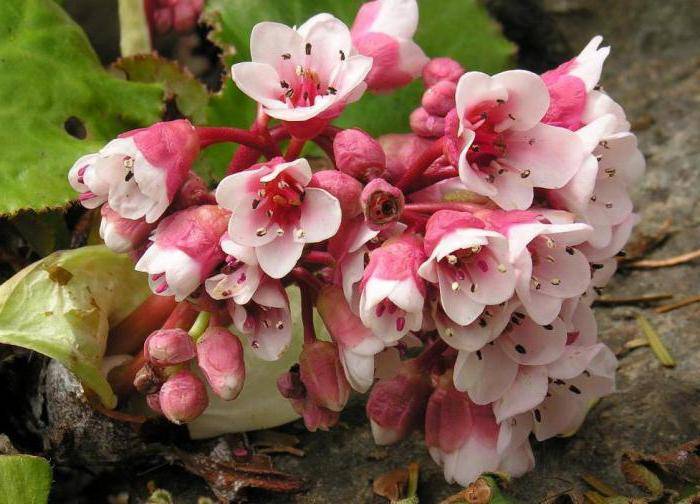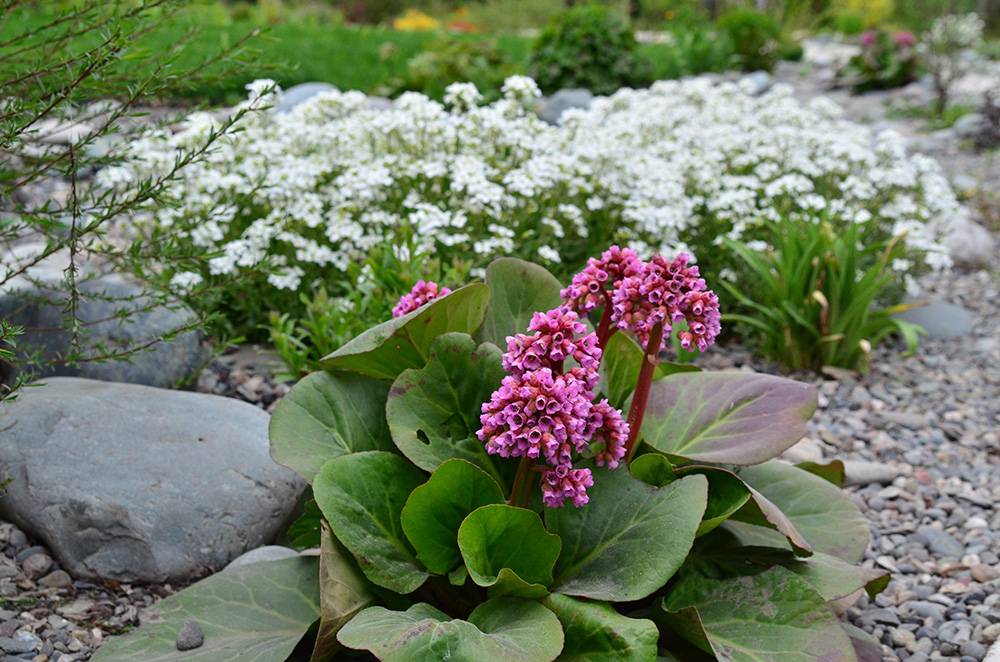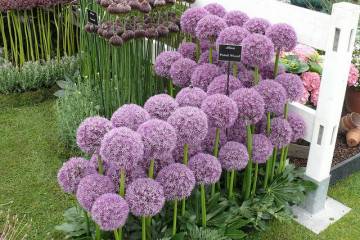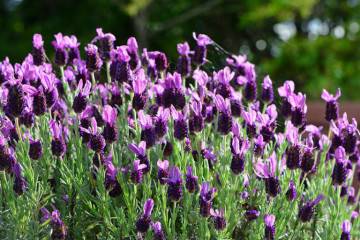Badan planting and care in the open field
Content:
Badan is a flower native to Asia. The ornamental bush was first brought to Europe by the German botanist Karl August von Bergen. Since then, the plant began to gain popularity among gardeners and florists around the world. Badan, unpretentious to climatic conditions, can be grown even in the coldest countries.
Description of the Badan plant
Badan is a plant with leathery ornamental leaves, belongs to the Saxifrage family. Together with colorful blooms, they create a wonderful ensemble in the garden plots. A flower in one place can grow for 15 years without transplanting. Resistant to drought and frost, it can retain foliage even after winter.
It is a small, compact perennial flower that does not exceed half a meter in height. Leaves of deep dark green color, collected in a rosette at the base of the stem. Closer to autumn, the foliage acquires orange, red and brown hues.
Flowers come in different colors, depending on the type and variety of plants: white, pink, lilac, purple. The buds are collected in panicle inflorescences and are located on thick peduncles. The grass begins to bloom in May or June and pleases the owner for a month.
Popular species and varieties
In nature, there are many types of badan that grow in various parts of the planet. In northern latitudes, two species are grown: thick-leaved and heart-leaved.
Famous varieties of badan:
- Schmidt. It has wing-shaped leaves and bright red flowers. One of the most popular varieties in European countries.
- Ak-Tru. Very large, in comparison with other varieties, it reaches up to 50 centimeters in height. The flowers are lilac.
- German hybrid varieties named after famous composers: Beethoven, Borodin, Bach, Bartok, Brahms. They are distinguished by high winter hardiness and large buds.
The healing properties of badan
For medicinal purposes, the roots and leaves of the berry are used. The healing properties of a useful plant:
- normalizes the work of the gastrointestinal tract;
- relieves inflammation;
- heals wounds and burns;
- fights acne and boils;
- has a sedative property;
- normalizes the genitourinary system;
- strengthens the body and improves immunity.
Badan: planting and care in the open field
Badan flower is not considered capricious - planting and care in the open field presuppose the observance of simple rules.
The flower grows in any area, both darkened and illuminated. The best option is a place with partial shade. The plant is planted in spring or late autumn. The holes are dug at a distance of at least 40 centimeters from each other. Bushes are planted just above the border of the beginning of the stem. After planting, the berry does not need watering. The first irrigation is carried out only two weeks later.
Planting rhizomes with rosettes
Dig out the rhizomes together with a clod of earth. And together with the land they are transplanted to a new place. A hole is pre-dug out larger than the diameter of the lump at the roots.
It is necessary to add humus or compost to the bottom of the hole, and fill the hole with a fertile substrate.When digging up the rhizomes, care must be taken not to damage them.
Planting berry rhizomes with dormant buds
When a badan with rhizomes with dormant buds is transplanted, it is necessary to carefully remove the earth from them.
The rhizome for planting must have at least 5 dormant buds. Before planting in open ground, the rhizomes are placed for 4 hours in a solution of potassium permanganate. The pits should be wider than the rhizomes.
The description of the composition of the substrate for planting is the same for all varieties: peat, humus, earth and a little river sand. Rhizomes are placed in holes and covered with a substrate.
Planting and growing badan in pots
The bottom of the pots is covered with a layer of drainage material: expanded clay, small pebbles, you can take rubble.
Then half of the container is covered with a substrate of compost, sand and sod land. Badan is placed on top of the substrate and, holding it with one hand, is poured around with the remaining substrate. They are tamped, watered and mulched with decorative pebbles or gravel.
Vegetative breeding method
Badan can reproduce by cuttings - in this case, the procedure is carried out in the spring.
It is necessary to choose young rosettes with a part of the main rhizome and several leaves. Several cuttings are cut and planted in prepared holes at a distance of 40 centimeters from each other. From the second week, they begin to regularly water the bushes.
Plant pruning
Pruning is carried out so that the plant does not weaken. The procedure is carried out after the incense has faded and its buds wither. At this time, the peduncles are cut off. In autumn, pruning of old shoots and leaves is carried out.
Seed propagation
How to propagate incense seeds? First of all, you need to select uninfected and healthy planting material. It is better to plant seeds in the autumn, this method contributes to a better germination of seeds.
After another year, it is necessary to plant all the seedlings in separate places. The first flowering will begin only at the 4th year of the life of the bush.
Reproduction by dividing the bush
Propagation of badan by dividing the bush can be carried out both in spring and autumn. You need to separate a part of the root from the shrub, then you need to plant it in a separate place. The distance between the bushes is at least 30 centimeters.
How to care for a plant outdoors
Growing and caring for badan does not require special attention, the flower is not at all capricious. The main thing is to keep the soil moist and loose.
Badan loves loose fertile soil, where there will be no stagnation of moisture. The acidity level should be lowered. Alkalinity, on the other hand, is slightly overestimated. You can add a little lime to the soil to increase the alkali level.
On rainy days, the shrubs do not need to be watered. During dry periods, it is important to let the flower saturate with moisture, otherwise it will get sick. Irrigation water should be at room temperature, cold water promotes stagnation of moisture and the formation of fungal diseases.
The first time after planting, it is important to provide special care for the badan. Watering for the first time is carried out only after the formation of the first buds, the next time - at the very peak of flowering, the third watering - when all the buds have faded. From time to time you need to carefully loosen the soil, trying not to damage the soil.
In the spring and autumn, it is necessary to remove rotten and dried leaves, stems and buds. In the spring, mineral fertilizers are applied, and in the fall, organic and mineral dressings are made.
During flowering, care is suspended, which will disturb and injure the bush. During this period, it is necessary to monitor the lighting of the bushes - it should be moderate.Badan blooms well in illuminated areas.
The plant is very hardy and therefore does not need shelter. However, flower growers notice that after winter shelter with spruce branches, berry blossoms more abundantly, begins to grow faster and sooner awakens after wintering.
Growing problems
Badan is resistant to various diseases and pests. Problems arise from improper care.
Why does not bloom berry, what to do in this case? A flowering plant should bloom in the summer for a month. If this does not happen, then there may have been a mistake in the landing or during the departure.
Excessive grooming can also hurt. During flowering, it is not necessary to disturb the flowers once again, as well as to feed them with fertilizers, especially in which there is nitrogen.
Leaves curl
Due to severe drought and prolonged exposure to the sun, the leaves of the bush may begin to turn yellow and curl. The problem may arise at the very peak of flowering, which is why many growers are perplexed: "Badan turns yellow in June, what to do?" If no action is taken in time, the leaves will fall off along with the flowers.
It is necessary to monitor the quantity and quality of watering. Water the flower when the top layer of the soil dries up and spray the ground part of the bush during dry periods.
Pest and disease control
Very rarely, with abundant watering and unfavorable conditions, the flower can be affected by the fungus. The fight against infections is carried out with the help of special preparations of fungicides. You can use folk methods, but they are not as effective. With fungal diseases, the plant can completely die, so every minute is precious.
Use in landscape design
Badan is widely used in landscape design. In addition to simple flower beds in gardens and park compositions, they are decorated with rock gardens and festive locations. Often used to create raised flower beds with stone props.
To find out the reasons for the poor condition of the flower, you need to review all the points of caring for it. It is quite possible that a mistake has been made somewhere. Thanks to its decorative leaves and flowers, bergenia will be a beautiful addition to the garden. At the same time, even novice flower lovers can grow it.


